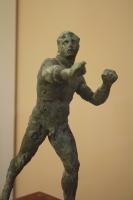Kalinowski, Angela
Pages
-

-
Pankratiast
-
Bronze statue depicting a nude athlete with leather thongs wrapped around his hands, identifying him as a pankratiast., Dates to c. 2nd century BCE.
-

-
Pelike with Athlete
-
Red-figure pelike depicting a nude male athlete holding a stick in one hand and a strigil in the other facing two clothed women holding various objects. On the reverse three male draped youths are depicted, one of which holds a stick., Dates to c. 440-420 BCE and is attributed to the Pisticci Painter., British Museum. “pelike.” The British Museum Collections Online. Accessed November 22, 2017.
http://www.britishmuseum.org/research/collection_online/collection_object_details.aspx?objectId=463182&partId=1&searchText=greek
-

-
Pelike with Athletes
-
Red-figure pelike. On the obverse a female figure is depicted holding out a wreath to a nude male youth to crown him as a victorious athlete. The athlete holds drapery on his arms and a staff in his hand. On the reverse are two ephebi wearing himations, each holding a staff in his hand and facing each other., Dates to c. 420-400 BCE. The female figure has been identified as possibly Nike., British Museum. “pelike.” The British Museum Collections Online. Accessed July 6, 2017. http://www.britishmuseum.org/research/collection_online/collection_object_details.aspx?objectId=463181&partId=1&searchText=greek+athlete&page=1
-

-
Pelike with Athletes
-
Red-figure pelike depicting athletes and a paidotribes. On the obverse, a nude male discobolos wearing a wreath and holding a discus faces a seated paidotribes who wears a wreath and is holding a staff. On the reverse, a nude male athlete wearing a fillet and holding a stick., Dates to c. 460-430 BCE. The stick the nude athlete holds has been identified as potentially a hurling rod (British Museum 2017).
British Museum. “pelike.” The British Museum Collections Online. Accessed July 17, 2017. http://www.britishmuseum.org/research/collection_online/collection_object_details.aspx?objectId=399105&partId=1&searchText=greek+athlete&page=1
-

-
Plaque with Cupids Boxing and Wrestling
-
Bronze plaque depicting four nude cupids boxing and wrestling in silver and gold inlay., British Museum. “plaque.” The British Museum Collections Online. Accessed November 22, 2017.
http://www.britishmuseum.org/research/collection_online/collection_object_details.aspx?objectId=399734&partId=1&searchText=roman
-

-
Relief with Gladiators
-
Fragmentary relief commemorating a contraretiarius' (type of gladiator) victories against various retiarii (another type of gladiator). The main image depicts three gladiators in various types of armor, one holding a sword. An inscription above the gladiators indicates that he won 'I, XI, XII' fights and the defeated gladiators' names are as follows: Improbus, Pantheriscus, and Ilarus., Dates to c. 3rd century CE.
-

-
Relief with Gladiators
-
This fragmentary marble relief is broken away on three sides. It depicts a retiarius fighting a secutor. The retiarius stands on a platform (pons, or bridge), he holds a trident and knife in his left hand, and in his right hand he holds a stone which he is about to hurl at the secutor, who is mounting the ramp toward him. Between the feet of the retiarius is a pile of stones. The secutor wears a helmet with a plain crest and has a rectangular shield on his extended right arm and a gladius in his left. Although we can identify the types of gladiator as a retiarius and a secutor, when they fought for the possession of a platform as portrayed on this relief, they are called pontiarii (‘bridge men’). Inscriptions identify the gladiators as [Ἀγορ]άκριτος, '[Agor]kritos', left; and Μάρισκος, Mariskos, right. In the space below the pons the inscription reads ἀπελύθη ἔξω λούδου - 'Freed from the games or from the ludus'., Dates to c. 2nd-3rd century CE. The inscriptions record the names of the combatants and that one of them, most likely Agoraktritos the retiarius was freed not just from this combat but from the games or the ludus in general., Junkelmann M. 2000, Das Spiel mit dem Tod, Mainz.
Bacchielli L. 1989, “I pontiarii: una definizione per via iconografica”, dans L’Africa romana VII 1989, p. 769-772.
Pages
